Android 本应用数据清除管理器DataCleanManager
1.整体分析
1.1.源代码先给出了,可以直接Copy。

/** * 本应用数据清除管理器 */ public class DataCleanManager { /** * * 清除本应用内部缓存(/data/data/com.xxx.xxx/cache) * * * * @param context */ public static void cleanInternalCache(Context context) { deleteFilesByDirectory(context.getCacheDir()); } /** * * 清除本应用所有数据库(/data/data/com.xxx.xxx/databases) * * * * @param context */ public static void cleanDatabases(Context context) { deleteFilesByDirectory(new File("/data/data/" + context.getPackageName() + "/databases")); } /** * * 清除本应用SharedPreference(/data/data/com.xxx.xxx/shared_prefs) * * * @param context */ public static void cleanSharedPreference(Context context) { deleteFilesByDirectory(new File("/data/data/" + context.getPackageName() + "/shared_prefs")); } /** * * 按名字清除本应用数据库 * * * * @param context * @param dbName */ public static void cleanDatabaseByName(Context context, String dbName) { context.deleteDatabase(dbName); } /** * * 清除/data/data/com.xxx.xxx/files下的内容 * * * * @param context */ public static void cleanFiles(Context context) { deleteFilesByDirectory(context.getFilesDir()); } /** * * 清除外部cache下的内容(/mnt/sdcard/android/data/com.xxx.xxx/cache) * * @param context */ public static void cleanExternalCache(Context context) { if (Environment.getExternalStorageState().equals( Environment.MEDIA_MOUNTED)) { deleteFilesByDirectory(context.getExternalCacheDir()); } } /** * * 清除自定义路径下的文件,使用需小心,请不要误删。而且只支持目录下的文件删除 * * * * @param filePath */ public static void cleanCustomCache(String filePath) { deleteFilesByDirectory(new File(filePath)); } /** * * 清除本应用所有的数据 * * * * @param context * @param filepath */ public static void cleanApplicationData(Context context, String... filepath) { cleanInternalCache(context); cleanExternalCache(context); cleanDatabases(context); cleanSharedPreference(context); cleanFiles(context); if (filepath == null) { return; } for (String filePath : filepath) { cleanCustomCache(filePath); } } /** * * 删除方法 这里只会删除某个文件夹下的文件,如果传入的directory是个文件,将不做处理 * * * * @param directory */ private static void deleteFilesByDirectory(File directory) { if (directory != null && directory.exists() && directory.isDirectory()) { for (File item : directory.listFiles()) { item.delete(); } } } // 获取文件 //Context.getExternalFilesDir() --> SDCard/Android/data/你的应用的包名/files/ 目录,一般放一些长时间保存的数据 //Context.getExternalCacheDir() --> SDCard/Android/data/你的应用包名/cache/目录,一般存放临时缓存数据 public static long getFolderSize(File file) throws Exception { long size = 0; try { File[] fileList = file.listFiles(); for (int i = 0; i < fileList.length; i++) { // 如果下面还有文件 if (fileList[i].isDirectory()) { size = size + getFolderSize(fileList[i]); } else { size = size + fileList[i].length(); } } } catch (Exception e) { e.printStackTrace(); } return size; } /** * 删除指定目录下文件及目录 * * @param deleteThisPath * @param filePath * @return */ public static void deleteFolderFile(String filePath, boolean deleteThisPath) { if (!TextUtils.isEmpty(filePath)) { try { File file = new File(filePath); if (file.isDirectory()) {// 如果下面还有文件 File files[] = file.listFiles(); for (int i = 0; i < files.length; i++) { deleteFolderFile(files[i].getAbsolutePath(), true); } } if (deleteThisPath) { if (!file.isDirectory()) {// 如果是文件,删除 file.delete(); } else {// 目录 if (file.listFiles().length == 0) {// 目录下没有文件或者目录,删除 file.delete(); } } } } catch (Exception e) { // TODO Auto-generated catch block e.printStackTrace(); } } } /** * 格式化单位 * * @param size * @return */ public static String getFormatSize(double size) { double kiloByte = size / 1024; if (kiloByte < 1) { return size + "Byte"; } double megaByte = kiloByte / 1024; if (megaByte < 1) { BigDecimal result1 = new BigDecimal(Double.toString(kiloByte)); return result1.setScale(2, BigDecimal.ROUND_HALF_UP) .toPlainString() + "KB"; } double gigaByte = megaByte / 1024; if (gigaByte < 1) { BigDecimal result2 = new BigDecimal(Double.toString(megaByte)); return result2.setScale(2, BigDecimal.ROUND_HALF_UP) .toPlainString() + "MB"; } double teraBytes = gigaByte / 1024; if (teraBytes < 1) { BigDecimal result3 = new BigDecimal(Double.toString(gigaByte)); return result3.setScale(2, BigDecimal.ROUND_HALF_UP) .toPlainString() + "GB"; } BigDecimal result4 = new BigDecimal(teraBytes); return result4.setScale(2, BigDecimal.ROUND_HALF_UP).toPlainString() + "TB"; } public static String getCacheSize(File file) throws Exception { return getFormatSize(getFolderSize(file)); } }
1.2.主要功能
清除内/外缓存,清除数据库,清除SharePreference,清除文件,删除文件,格式化单位等。
1.3.方法列表
- cleanInternalCache(Context)==>清除本应用内部缓存
- cleanDatabases(Context)==>清除本应用所有数据库
- cleanSharePreference(Context)==>清除本应用SharePreference
- cleanDatabaseByName(Context,String)==>按名字清除本应用数据库
- cleanFiles(Context)==>清除files下的内容
- cleanExternalCache(Context)==>清除外部缓存下的内容
- cleanCustomCache(String)==>清除自定义路径下的文件
- cleanApplicationData(Context context,String... filepath)==>清除本应用所有的数据
- deleteFilesByDirectory(File)==>删除某个文件夹下的文件
- getFolderSize(File)==>获取当前文件夹的大小,包括文件夹中的文件夹。
- deleteFolderFile(String,boolean)==>删除指定目录下下的文件及目录
- getFormatSize(double)==>格式化单位
- getCacheSize(File)==>获取缓存文件的大小
2.局部分析
2.1.清除本应用内部缓存
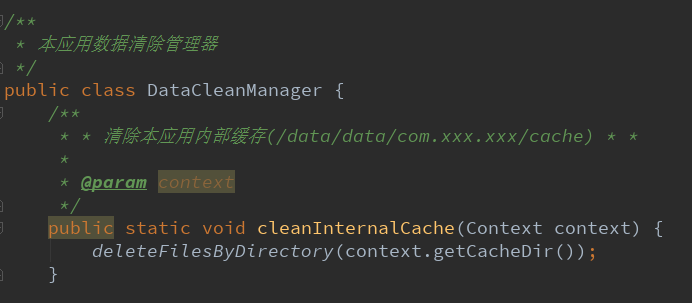
传入一个上下文,可以获取内部缓存路径,然后调用删除方法
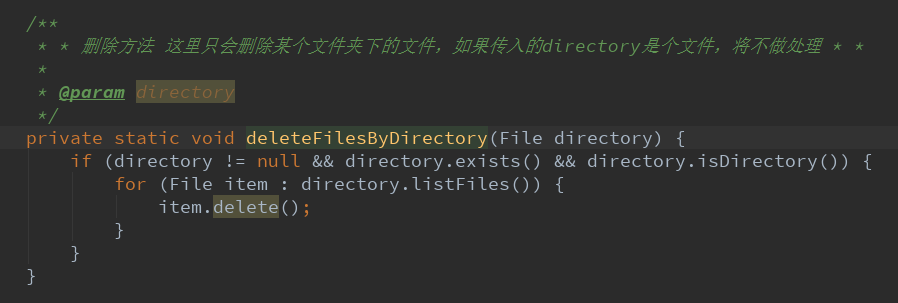
2.2.清除本应用所有数据库

然后同样调用了delete方法。
这里约定好数据库的文件路径有databases。
2.3.清除本应用SharePreference

同样调用了删除方法。
这里约定好数据库文件路径有shared_prefs。
2.4.按名字清除本应用数据库

这里调用了context中的方法,可以直接清除数据库。
2.5.清除本应用下files下的文件
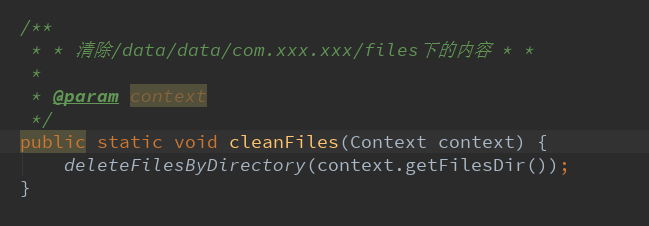
这里先通过context获取本应用files的地址,然后调用删除方法。
2.6.清除外部缓存下的文件
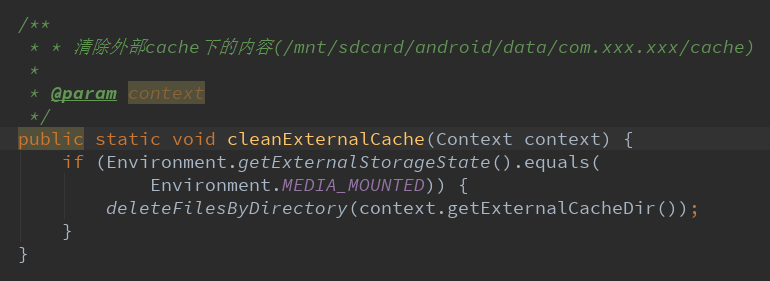
这里了先判断是否有外部缓存,然后通过context获取外部缓存地址,然后调用删除方法。
2.7.清除自定义路径下的文件

这里事先知道某个文件,即可调用删除方法,但是只支持目录下的文件删除。
2.8.清除本应用所有的数据
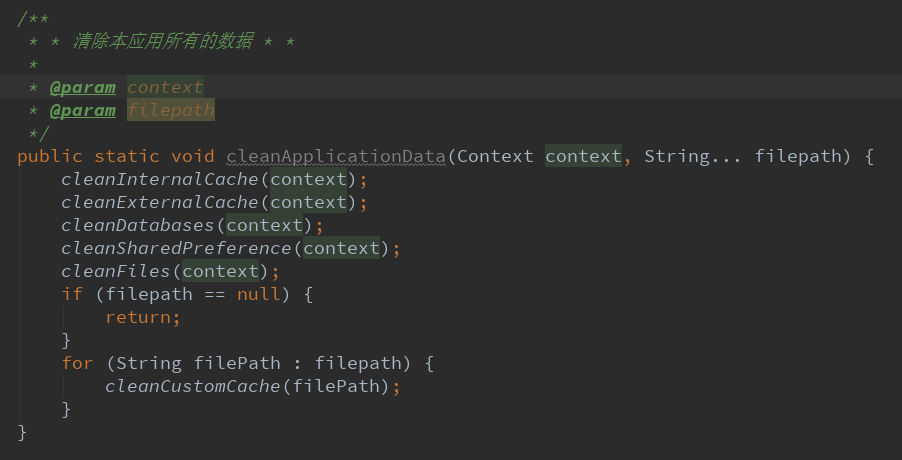
这里就是调用了上面所有的方法。
2.9.获取文件夹的大小(里面可能还有子目录)
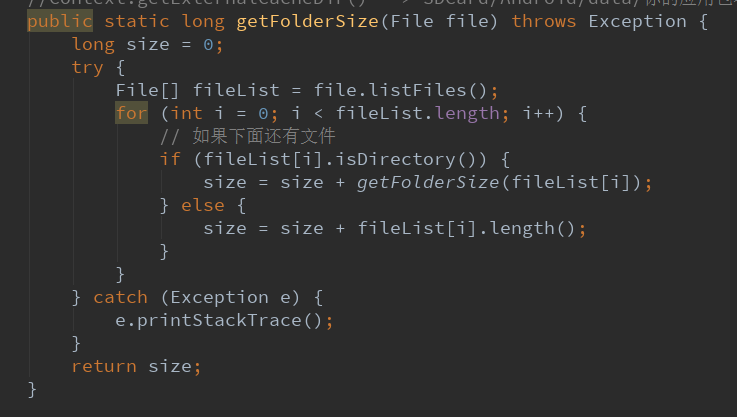
遍历每一个文件,获取size大小之和。
2.10.删除指定目录下文件及目录
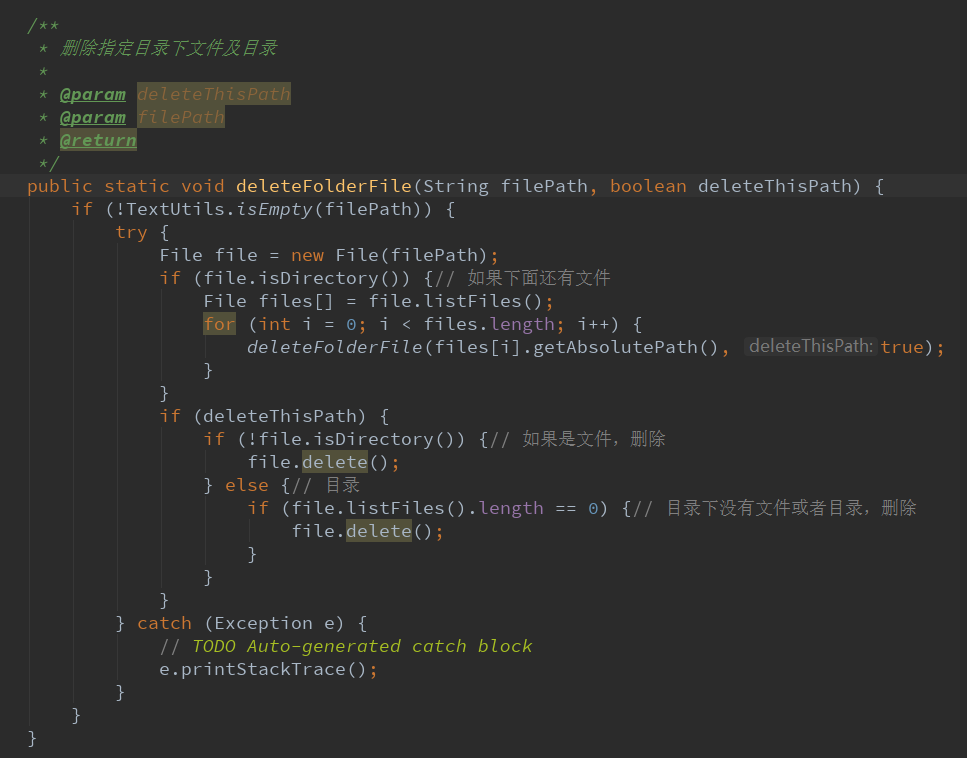
给一个指定目录,然后后面那个参数有点多余了。利用file.delete()即可删除文件。
2.11.格式化单位
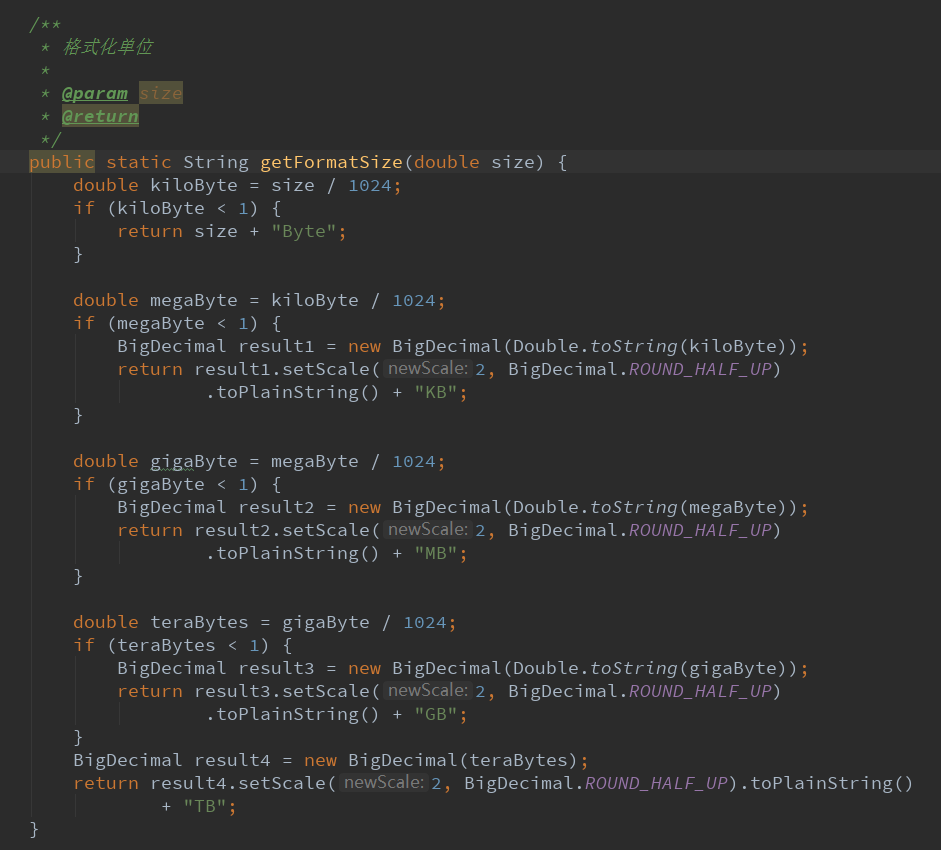
给定一个size,然后计算成合理的单位。
2.12.获取缓存大小

得到一个file参数,判断文件夹的大小,然后再格式化单位,从而知道了缓存大小。
3.用法实例
3.1.比如在一个设置的活动
要知道缓存的大小。
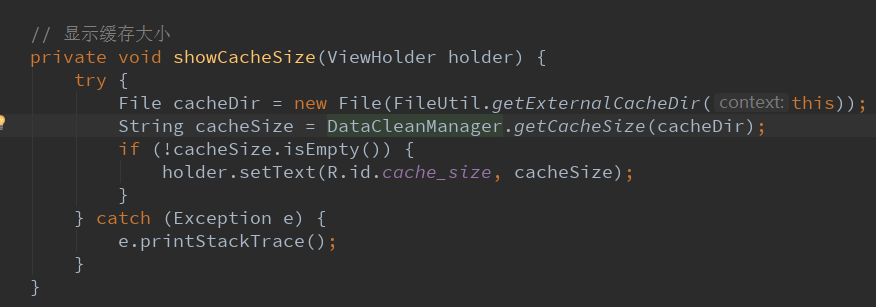
调用了DataCleanManager的一个getCacheSize函数,事先通过FileUtil获取外部缓存地址。
3.2.点击了之后清除缓存

这里给出了一个指定目录,而且不删除路径。



